Papers by Mónica Morayma Solórzano Kraemer

PeerJ, 2015
One new subfamily, four new genera and 10 new species of Psychodidae are described from Burmese a... more One new subfamily, four new genera and 10 new species of Psychodidae are described from Burmese amber which significantly increases our knowledge about this group in the Cretaceous. Protopsychodinae n. subfam. probably represents the oldest known ancestor of modern Psychodinae and includes three species within two genera: Datzia setosa gen. et sp. n., Datzia bispina gen. et sp. n., and Mandalayia beumersorum gen. et sp. n. Sycoracinae and Phlebotominae are represented by two genera each in the studied material, Palaeoparasycorax globosus gen. et sp. n., Palaeoparasycorax suppus gen. et sp. n., Parasycorax simplex sp. n., and Phlebotomites aphoe sp. n. and Phlebotomus vetus sp. n., respectively. Bruchomyiinae is represented by Nemopalpus quadrispiculatus sp. n. Furthermore, one genus of an incertae sedis subfamily, Bamara groehni gen. et sp. n., is described. The systematic positions of the new taxa are discussed.
PeerJ
Pondweed bugs (Hemiptera: Mesoveliidae), considered a sister group to all other Gerromorpha, are ... more Pondweed bugs (Hemiptera: Mesoveliidae), considered a sister group to all other Gerromorpha, are exceedingly rare as fossils. Therefore, each new discovery of a fossil mesoveliid is of high interest, giving new insight into their early evolutionary history and diversity and enabling the testing of their proposed relationships. Here, we report the discovery of new mesoveliid material from Spanish Lower Cretaceous (Albian) amber, which is the first such find in Spanish amber. To date, fossil records of this family only include one species from French Kimmeridgian as compression fossils, two species in French amber (Albian-Cenomanian boundary), and one in Dominican amber (Miocene). The discovery of two males and one female described and figured as Glaesivelia pulcherrima Sánchez-García…
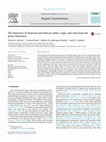
The comparison of the chemical composition of fossilized amber, copal, and resin is important for... more The comparison of the chemical composition of fossilized amber, copal, and resin is important for determining the botanic origin and original chemical composition of fossilized amber and copal, and for understanding the ecologic role of resin. Here we use solid phase microextraction-gas chromatography-mass spectrometry (SPME-GC-MS) to investigate the volatile and semi-volatile composition of amber, copal and resin from Africa and the Americas, produced by trees from the genus Hymenaea. We found there are four subgroups of Hymenaea resin, copal, and amber, based upon age and chemical similarity: African amber, American amber, African resin/copal (which also includes Colombian copal), and American resin/copal. This analysis allows us to narrow down the potential botanic origin of amber and copal samples, and also indicates that within this genus, resin similarity does not correspond closely with phylogenetic relationships. Therefore, resin chemistry may have been controlled by ecologic pressures, such as defence against herbivores, wood borers, humidity, and diseases and the original chemical composition of amber and copal could potentially be used to understand the role of resin in plant-insect interactions through time.
Comptes Rendus Palevol, 2010
Over the past six years, organic inclusions preserved in amber samples from outcrops worldwide ha... more Over the past six years, organic inclusions preserved in amber samples from outcrops worldwide have been discovered and imaged in 3D using propagation phase contrast based X-ray synchrotron imaging techniques at the European Synchrotron Radiation Facility (ESRF). A brief description of the techniques and protocols used for detecting and 3D non-destructive imaging of amber inclusions is provided. The latest results from the major amber projects in the ESRF are given, illustrating the increasing utility of the imaging capabilities of X-ray synchrotron phase contrast microtomography. derniers résultats des principaux projets engagés sur l'ambre à l'ESRF présentés ici montrent l'intérêt croissant des possibilités d'imagerie par microtomographie en rayonnements X synchrotron.
Comptes Rendus Palevol, 2010
Over the past six years, organic inclusions preserved in amber samples from outcrops worldwide ha... more Over the past six years, organic inclusions preserved in amber samples from outcrops worldwide have been discovered and imaged in 3D using propagation phase contrast based X-ray synchrotron imaging techniques at the European Synchrotron Radiation Facility (ESRF). A brief description of the techniques and protocols used for detecting and 3D non-destructive imaging of amber inclusions is provided. The latest results from the major amber projects in the ESRF are given, illustrating the increasing utility of the imaging capabilities of X-ray synchrotron phase contrast microtomography. derniers résultats des principaux projets engagés sur l'ambre à l'ESRF présentés ici montrent l'intérêt croissant des possibilités d'imagerie par microtomographie en rayonnements X synchrotron.
Cretaceous Research, 2009
Novelaria, a new genus of rhagionid of late Albian age with three new species, is the first recor... more Novelaria, a new genus of rhagionid of late Albian age with three new species, is the first record of this family from Charentes amber (southwestern France). The new genus is probably closely related to the recent genus Chrysopilus. However its relationship with the other fossils in amber is discussed. A key for separation of the new species is provided and
Comptes Rendus …, Jan 1, 2010
Over the past six years, organic inclusions preserved in amber samples from outcrops worldwide ha... more Over the past six years, organic inclusions preserved in amber samples from outcrops worldwide have been discovered and imaged in 3D using propagation phase contrast based X-ray synchrotron imaging techniques at the European Synchrotron Radiation Facility (ESRF). A brief description of the techniques and protocols used for detecting and 3D non-destructive imaging of amber inclusions is provided. The latest results from the major amber projects in the ESRF are given, illustrating the increasing utility of the imaging capabilities of X-ray synchrotron phase contrast microtomography. derniers résultats des principaux projets engagés sur l'ambre à l'ESRF présentés ici montrent l'intérêt croissant des possibilités d'imagerie par microtomographie en rayonnements X synchrotron.
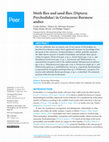
One new subfamily, four new genera and 10 new species of Psychodidae are described from Burmese a... more One new subfamily, four new genera and 10 new species of Psychodidae are described from Burmese amber which significantly increases our knowledge about this group in the Cretaceous. Protopsychodinae n. subfam. probably represents the oldest known ancestor of modern Psychodinae and includes three species within two genera: Datzia setosa gen. et sp. n., Datzia bispina gen. et sp. n., and Mandalayia beumersorum gen. et sp. n. Sycoracinae and Phlebotominae are represented by two genera each in the studied material, Palaeoparasycorax globosus gen. et sp. n., Palaeoparasycorax suppus gen. et sp. n., Parasycorax simplex sp. n., and Phlebotomites aphoe sp. n. and Phlebotomus vetus sp. n., respectively. Bruchomyiinae is represented by Nemopalpus quadrispiculatus sp. n. Furthermore, one genus of an incertae sedis subfamily, Bamara groehni gen. et sp. n., is described. The systematic positions of the new taxa are discussed.

Two new species are described from Mexican amber
(15–20 Ma): Cenocephalus tenuis Peris and Solórz... more Two new species are described from Mexican amber
(15–20 Ma): Cenocephalus tenuis Peris and Solórzano
Kraemer sp. nov. and Tesserocerus simojovelensis Peris and
Solórzano Kraemer sp. nov. Cenocephalus, originally described
as living in Central and South America and then as
fossils from Early to Middle Miocene amber, is noted as morphologically
indistinguishable from Mitosoma, and originally
described as endemic from Madagascar. Thus, we consider
that a close taxonomic relationship exists, even if they are
not the same genus. New evidence of the species already described
in Platypodinae (Tesserocerini) from Mexican and
Dominican ambers (15–20 Ma) and the differences between
those species are discussed, complementing the original descriptions.
The paleobiogeography of Cenocephalus and
Mitosoma is analyzed, which strongly supports the hypothesis
of colonization from Afrotropical Madagascar to America prior
to Early to Middle Miocene (15–20 Ma) via sea currents.
Hymenaea was interpreted as the Mexican and Dominican
resin producers. Based on the analysis of fossil and current
distribution of such plants, our hypothesis considers that the
beetle dispersion occurred with Hymenaea, which was possibly
its host plant.
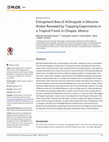
All entomological traps have a capturing bias, and amber, viewed as a trap, is no exception. Thus... more All entomological traps have a capturing bias, and amber, viewed as a trap, is no exception. Thus the fauna trapped in amber does not represent the total existing fauna of the former amber forest, rather the fauna living in and around the resin producing tree. In this paper we compare arthropods from a forest very similar to the reconstruction of the Miocene Mexican amber forest, and determine the bias of different trapping methods, including amber. We also show, using cluster analyses, measurements of the trapped arthropods, and guild distribution, that the amber trap is a complex entomological trap not comparable with a single artificial trap. At the order level, the most similar trap to amber is the sticky trap. However, in the case of Diptera, at the family level, the Malaise trap is also very similar to amber. Amber captured a higher diversity of arthropods than each of the artificial traps, based on our study of Mexican amber from the Middle Miocene, a time of climate optimum, where temperature and humidity were probably higher than in modern Central America. We conclude that the size bias is qualitatively independent of the kind of trap for non-extreme values. We suggest that frequent specimens in amber were not necessarily the most frequent arthropods in the former amber forest. Selected taxa with higher numbers of specimens appear in amber because of their ecology and behavior, usually closely related with a tree-inhabiting life. Finally, changes of diversity from the Middle Miocene to Recent time in Central and South America can be analyzed by comparing the rich amber faunas from Mexico and the Dominican Republic with the fauna trapped using sticky and Malaise traps in Central America.
A sterile liverwort inclusion in a piece of Miocene Mexican amber is described and assigned to t... more A sterile liverwort inclusion in a piece of Miocene Mexican amber is described and assigned to the extant genus Ceratolejeunea. The inclusion has entire leaves with a basal group of 2–4(– ca. 7) ocelli, rather thin- walled leaf cells, large ovoid lobules and bifid, suborbicular underleaves. This combination of characters does not fit the morphology of extant species. Accordingly, the fossil is described as Ceratolejeunea antiqua, sp. nov., making it the second liverwort species known from Mexican amber.
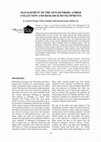
Amber and copal are fascinating materials due to their ability to preserve fossils in incredible ... more Amber and copal are fascinating materials due to their ability to preserve fossils in incredible detail, but they are also very fragile materials that quickly deteriorate when stored in unsuitable conditions. The copal surface becomes cracked after some years and amber becomes darker and fragile over time. Few studies have dealt with the problem of amber storage, but they highlighted the bad effects of environmental conditions (temperature, relative humidity, light and oxidising agents). After the acquisition of important collections of amber and copal, the Senckenberg museum developed an original storage system for its amber collection. New air-conditioned stores protect the material from temperature, relative humidity and/or light intensity variations, whilst embedding in artificial resin is used to protect the samples from the atmosphere oxidising agents. The Senckenberg museum has thus a very secure amber storage system.
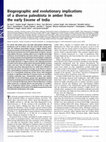
For nearly 100 million years, the India subcontinent drifted from Gondwana until its collision wi... more For nearly 100 million years, the India subcontinent drifted from Gondwana until its collision with Asia some 50 Ma, during which time the landmass presumably evolved a highly endemic biota. Recentexcavationsofrichoutcropsof50–52-million-year-oldamber with diverseinclusions from the CambayShale ofGujarat,western Indiaaddressthisissue.Cambayamberoccursinligniticandmuddy sediments concentrated by near-shore chenier systems; its chemis- tryandtheanatomyofassociatedfossilwoodindicatesadefinitive sourceofDipterocarpaceae.Theamberisverypartiallypolymerized and readily dissolves in organic solvents, thus allowing extraction ofwholeinsectswhosecuticleretainsmicroscopicfidelity.Fourteen orders and more than 55 families and 100 species of arthropod inclusions have been discovered thus far, which have affinities to taxa from the Eocene of northern Europe, to the Recent of Austra- lasia,andtheMiocenetoRecentoftropicalAmerica.Thus,Indiajust prior to or immediately following contact shows little biological insularity. A significant diversity of eusocial insects are fossilized, including corbiculate bees, rhinotermitid termites, and modern subfamilies of ants (Formicidae), groups that apparently radiated duringthecontemporaneousEarlyEoceneClimaticOptimumorjust priortoitduringthePaleocene-EoceneThermalMaximum.Cambay amber preserves a uniquely diverse and early biota of a modern- type of broad-leaf tropical forest, revealing 50 Ma of stasis and changeinbiologicalcommunitiesofthedipterocarpprimaryforests that dominate southeastern Asia today.
Novelaria, a new genus of rhagionid of late Albian age with three new species, is the first recor... more Novelaria, a new genus of rhagionid of late Albian age with three new species, is the first record of this family from Charentes amber (southwestern France). The new genus is probably closely related to the recent genus Chrysopilus. However its relationship with the other fossils in amber is discussed. A key for separation of the new species is provided and the diversity of the family during the Cretaceous is also briefly discussed.
A new species of Planthopper, Nogodina chiapaneca sp. nov. from the Mexican Chiapas amber (southe... more A new species of Planthopper, Nogodina chiapaneca sp. nov. from the Mexican Chiapas amber (southeast Mexico) is described. The new species belongs to Nogodinidae: Nogodinini: Nogodinina. This is the second nogodinid species described from Mexican amber. Both species belong to Nogodinina, a taxon with a Neotropical distribution. The only recent species of Nogodina, N. reticulata, ranges from Honduras to Brazil and is unknown from Mexico yet.
The new genus and species, Phlebotoiella eoindianensis, from the Eocene Vastan amber deposits in ... more The new genus and species, Phlebotoiella eoindianensis, from the Eocene Vastan amber deposits in western India is described and illustrated. This marks the first Psychodidae to be described from Vastan amber. The relationship of this new genus is discussed as well as its biogeographic implications.
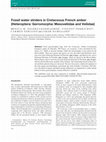
Fossil gerromorphan bugs from the Cretaceous (Albian–Cenomanian boundary) amber of Charentes, SW ... more Fossil gerromorphan bugs from the Cretaceous (Albian–Cenomanian boundary) amber of Charentes, SW France, are reviewed. A larva described by Per- richot et al. (2005) as incertae familiae within the Gerromorpha is now placed in the Mesoveliidae. Three new genera and species are also described and illustrated: Emil- ianovelia audax Solórzano Kraemer &Perrichot,gen.etsp.n.,and Malenavelia videris Solórzano Kraemer & Perrichot, gen. et sp.n., which are placed in the Mesoveliidae: Mesoveliinae; and Arcantivelia petraudi Solórzano Kraemer & Perrichot, gen. et sp.n., whichisthefirstMesozoicmemberoftheVeliinae.Therelationshipsbetweenthesefos- sils and their palaeoecology are discussed. The new discoveries confirm the antiquity of the semi-aquatic gerromorphans, particularly the clade (Veliidae+Gerridae). The habi- tat is described as aquatic and likely marine-influenced, yet adaptation to a fully marine habitat in these gerromorphans remains difficult to establish.
Five new species of Tachydromiinae (Empididae s.l.) are described, four from Mexican amber (Chaet... more Five new species of Tachydromiinae (Empididae s.l.) are described, four from Mexican amber (Chaetodromia pulchra sp. nov., Drapetis dissentis sp. nov., Micrempis brevis sp. nov., Stilpon mexicanus sp. nov.) and one from Dominican amber (Chersodromia dominicana sp. nov.). These are the first tachydromiine species described from New World Tertiary (Oligocene-Miocene) ambers. Thirty-two Tertiary fossil species of Tachydromiinae are now known worldwide.
Eohomopterus simojovelensis n. sp.,
the first fossil record of the subfamily Paussinae (Cole... more Eohomopterus simojovelensis n. sp.,
the first fossil record of the subfamily Paussinae (Coleoptera: Carabi- dae) from the Miocene amber of the Simojovel area, Chiapas, Mexico, is described. The morphology of the new spe- cies is compared with Eohomopterus poinari N AGEL , 1997 from Dominican amber as well as with extant represen- tatives of Eohomopterus , and the biogeographical implications are discussed.
Uploads
Papers by Mónica Morayma Solórzano Kraemer
(15–20 Ma): Cenocephalus tenuis Peris and Solórzano
Kraemer sp. nov. and Tesserocerus simojovelensis Peris and
Solórzano Kraemer sp. nov. Cenocephalus, originally described
as living in Central and South America and then as
fossils from Early to Middle Miocene amber, is noted as morphologically
indistinguishable from Mitosoma, and originally
described as endemic from Madagascar. Thus, we consider
that a close taxonomic relationship exists, even if they are
not the same genus. New evidence of the species already described
in Platypodinae (Tesserocerini) from Mexican and
Dominican ambers (15–20 Ma) and the differences between
those species are discussed, complementing the original descriptions.
The paleobiogeography of Cenocephalus and
Mitosoma is analyzed, which strongly supports the hypothesis
of colonization from Afrotropical Madagascar to America prior
to Early to Middle Miocene (15–20 Ma) via sea currents.
Hymenaea was interpreted as the Mexican and Dominican
resin producers. Based on the analysis of fossil and current
distribution of such plants, our hypothesis considers that the
beetle dispersion occurred with Hymenaea, which was possibly
its host plant.
the first fossil record of the subfamily Paussinae (Coleoptera: Carabi- dae) from the Miocene amber of the Simojovel area, Chiapas, Mexico, is described. The morphology of the new spe- cies is compared with Eohomopterus poinari N AGEL , 1997 from Dominican amber as well as with extant represen- tatives of Eohomopterus , and the biogeographical implications are discussed.
(15–20 Ma): Cenocephalus tenuis Peris and Solórzano
Kraemer sp. nov. and Tesserocerus simojovelensis Peris and
Solórzano Kraemer sp. nov. Cenocephalus, originally described
as living in Central and South America and then as
fossils from Early to Middle Miocene amber, is noted as morphologically
indistinguishable from Mitosoma, and originally
described as endemic from Madagascar. Thus, we consider
that a close taxonomic relationship exists, even if they are
not the same genus. New evidence of the species already described
in Platypodinae (Tesserocerini) from Mexican and
Dominican ambers (15–20 Ma) and the differences between
those species are discussed, complementing the original descriptions.
The paleobiogeography of Cenocephalus and
Mitosoma is analyzed, which strongly supports the hypothesis
of colonization from Afrotropical Madagascar to America prior
to Early to Middle Miocene (15–20 Ma) via sea currents.
Hymenaea was interpreted as the Mexican and Dominican
resin producers. Based on the analysis of fossil and current
distribution of such plants, our hypothesis considers that the
beetle dispersion occurred with Hymenaea, which was possibly
its host plant.
the first fossil record of the subfamily Paussinae (Coleoptera: Carabi- dae) from the Miocene amber of the Simojovel area, Chiapas, Mexico, is described. The morphology of the new spe- cies is compared with Eohomopterus poinari N AGEL , 1997 from Dominican amber as well as with extant represen- tatives of Eohomopterus , and the biogeographical implications are discussed.